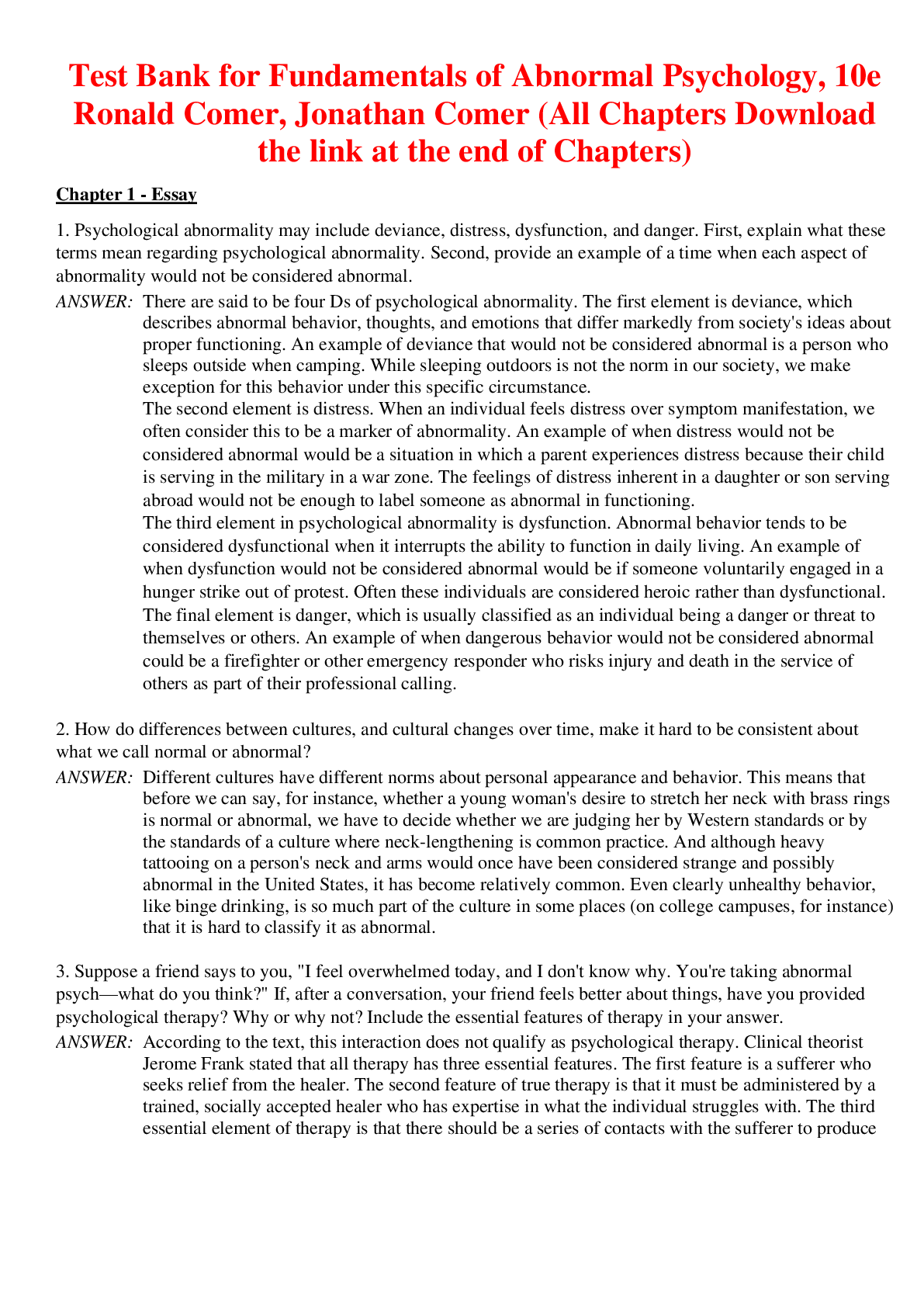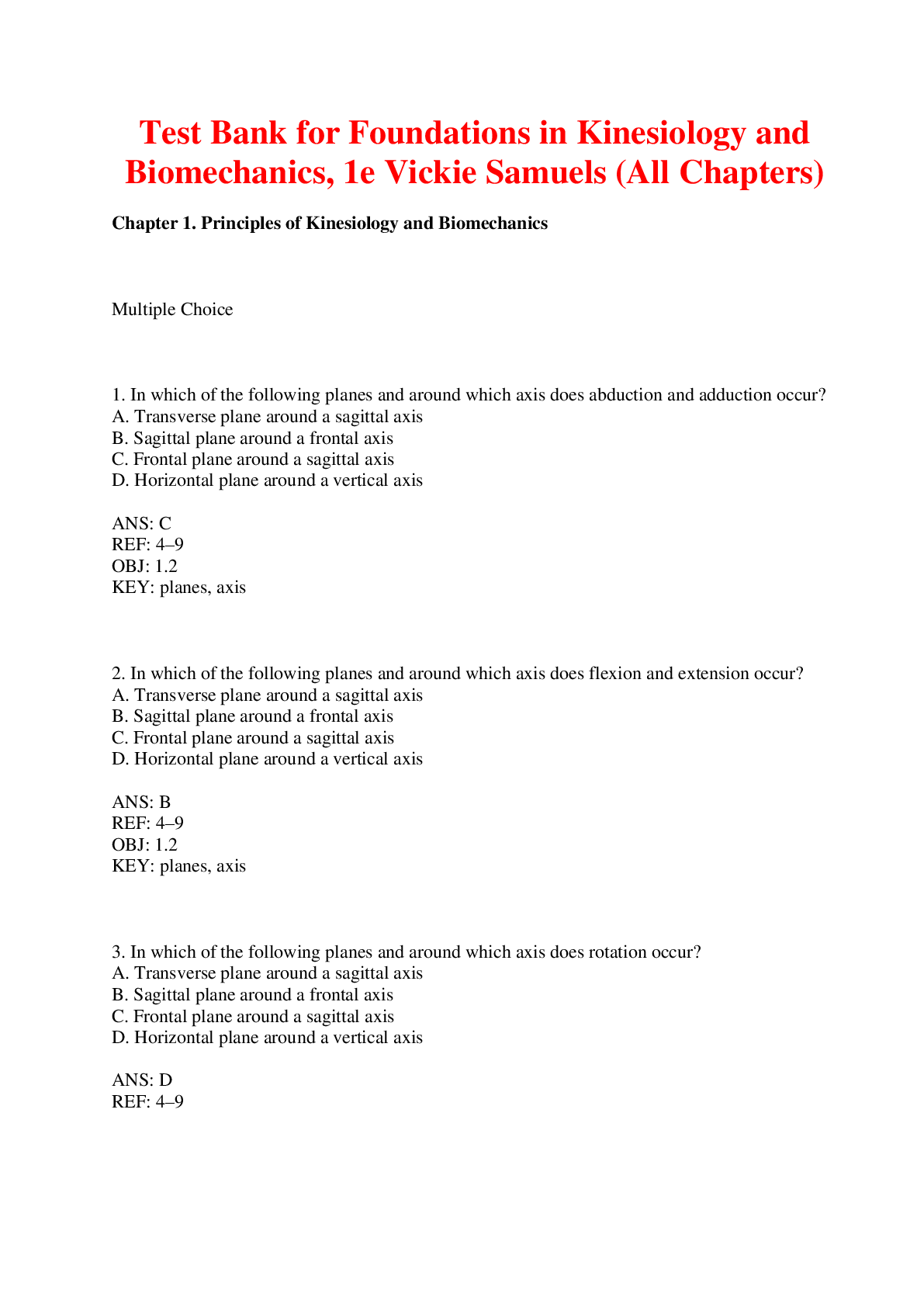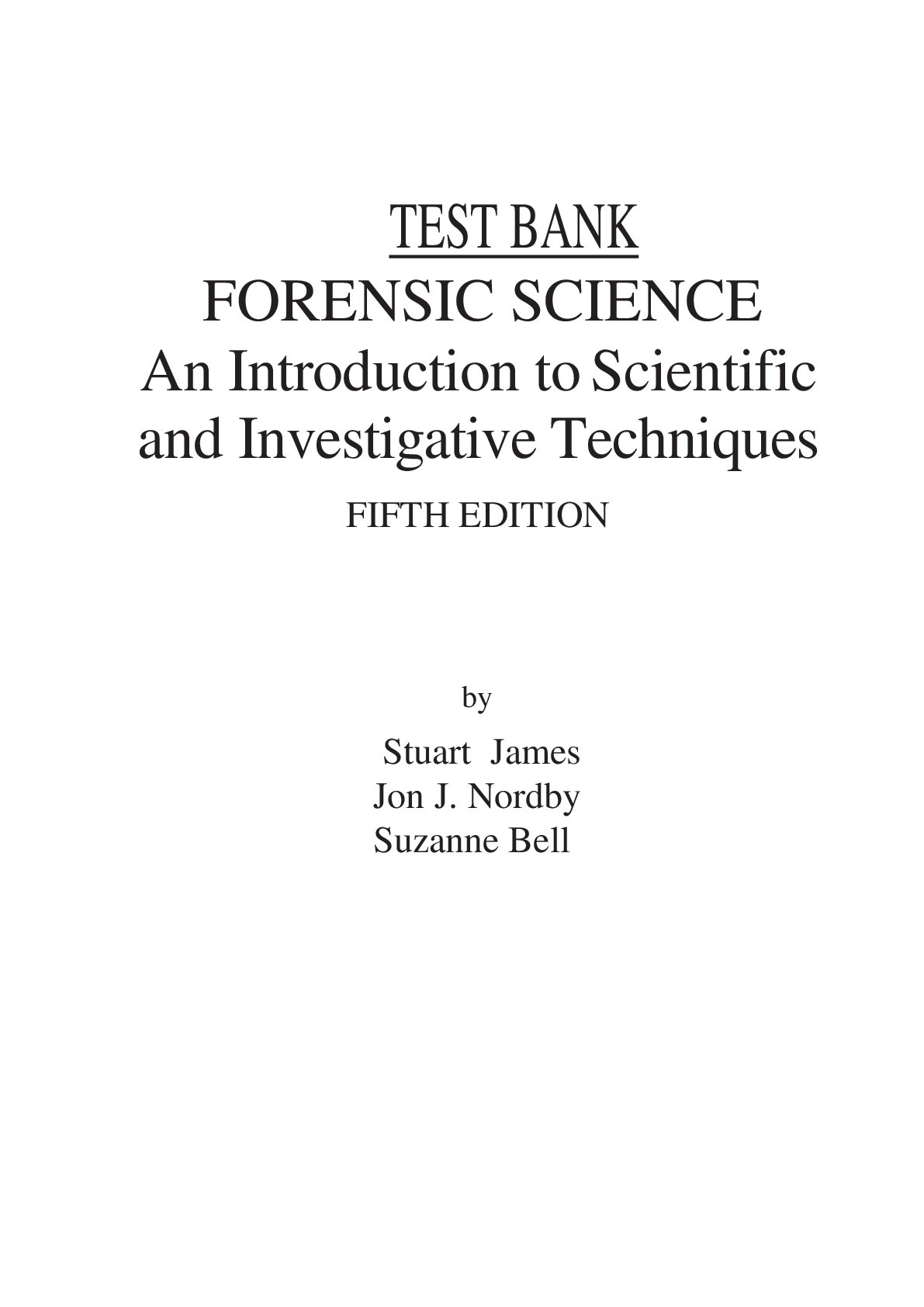Chapter 21: Musculoskeletal System Test Bank Seidel’s Guide to Physical Examination-8th Edition-Jane W. Ball
Document Content and Description Below
Chapter 21: Musculoskeletal System
Test Bank Seidel’s Guide to Physical Examination-8th Edition-Jane W. Ball
MULTIPLE CHOICE
1.Which joints are frequently moving articulations that are enclosed b
...
y a capsule of fibrous articular
cartilage?
a.Synarthroses
b.Synchondroses
c.Amphiarthroses
d.Synovial
ANS: D Synovial articulations are freely moving joints that are enclosed by a compartment made up of
cartilage and ligaments. Synarthroses are immovable joints. Synchondroses are immovable joints.
Amphiarthroses are slightly movable.
2.Fluid that lubricates articular cavities is called:
a.blood.
b.synovial fluid.
c.mucus.
d.cerumen.
ANS: B Articular cavities are lined with synovial membrane, which secretes synovial fluid that provides
lubrication for the joint to move. Blood does not act as a lubricant. Mucus should not be found in articular
cavities. Cerumen is ear wax.
3.Joints are held together by:
a.tendons.
b.ligaments.
c.muscles.
d.cartilage.
ANS: B Bones are held together within a joint by ligaments. Tendons attach muscle to bone, bones are
not held together by muscles, and cartilage forms most of the joints in the adult skeleton and merely acts
as a shock absorber.
4.Bones are attached to muscles by:
a.tendons.
b.ligaments.
c.muscles.
d.cartilage.
ANS: A Tendons attach muscle to bone. Ligaments attach bone to bone. Muscles are not bound together
by other muscles. Cartilage helps in the production of new bone and acts as an insulator for bones in joints.
5.An increase in muscle tone is known as:
a.crepitus.
b.effusion.
c.spasticity.
d.atrophy.
ANS: C An increase in muscle tone is referred to as spasticity.
CHAPTER 21: MUSCULOSKELETAL SYSTEM
6.The type of joint that has the widest range of motion in all planes is the:
a.ball-and-socket.
b.condyloid.
c.gliding.
d.saddle.
ANS: A The ball-and-socket joint is the joint that has the widest range of motion (e.g., the hip joint). A
condyloid joint may only move in two planes. A gliding joint is only able to glide. A saddle joint has no axial
rotation.
7.Spinal vertebrae are separated from each other by:
a.bursae.
b.tendons.
c.disks.
d.ligaments.
ANS: C Except for sacral vertebrae, the spinal vertebrae are separated from one another by disks. Spinal
movement is achieved by paraspinous muscles, tendons, and ligaments. Bursae are located in the knee,
elbow, shoulder, and hip.
8.The glenohumeral joint is the other name for the:
a.elbow.
b.shoulder.
c.wrist.
d.scapula.
ANS: B The shoulder joint, also called the glenohumeral joint, consists of the union between the humerus
and scapula.
9.The joint where the humerus, radius, and ulna articulate is the:
a.wrist.
b.elbow.
c.shoulder.
d.clavicle.
ANS: B The elbow is the site where the humerus, radius, and ulna meet. The wrist is made up of the
radius and the carpal bones of the hand. The shoulder is made up of the humerus and scapula. The clavicle
connects to the scapula but not to the humerus.
10.The articulation of the radius and carpal bones is the:
a.wrist.
b.elbow.
c.shoulder.
d.clavicle.
ANS: A The joint comprising the radius and carpal bones is called the wrist.
11.The cruciate ligaments of the knee provide for:
a.anterior and posterior stability.
b.medial and lateral stability.
c.movement on one plane.
d.pivoting and rotation.
ANS: A The cruciate ligaments of the knee are positioned as to provide anterior and posterior stability.
The collateral ligaments maintain medial and lateral stability. The knee joint is a hinge joint that allows
movement in one plane.
12.Medial and lateral surfaces of the tibiotalar joint are protected by:
a.bursae.
b.tendons.
c.muscles.
d.ligaments.
ANS: D The ankle joint, or tibiotalar joint, is protected by ligaments on the medial and lateral sides.
13.The suprapatellar bursa separates the patella, quadriceps tendon, and muscle from the:
a.tibia.
b.fibula.
c.femur.
d.pelvis.
ANS: C The suprapatellar bursa separates the knee, quadriceps, and muscle from the femur.
14.The tibia, fibula, and talus articulate to form the:
a.ankle.
b.knee.
c.hip.
d.pelvis.
ANS: A The tibia, fibula, and talus (or heel) join to form the ankle.
15.Long bones in children have growth plates known as:
a.epiphyses.
b.epicondyles.
c.synovium.
d.fossae.
ANS: A Epiphyses are the growth plates found in long bones in children.
16.The elasticity of pelvic ligaments and softening of cartilage in a pregnant woman are the result of:
a.decreased mineral deposition.
b.increased hormone secretion.
c.uterine enlargement.
d.gait changes.
ANS: B Increased hormone secretion during pregnancy is responsible for the elasticity of pelvic ligaments
and softening of the cartilage. These changes help accommodate the growing fetus.
17.Skeletal changes in older adults are the result of:
a.increased bone deposition.
b.increased bone resorption.
c.decreased bone deposition.
d.decreased bone resorption.
ANS: B With age, the skeletal system changes. One of the dramatic changes in skeletal equilibrium is that
bone resorption dominates bone deposition.
18.The family history for a patient with joint pain should include information about siblings with:
a.trauma to the skeletal system.
b.chronic atopic dermatitis.
c.genetic disorders.
d.obesity.
ANS: C An important history to obtain for a patient with joint pain would be family history of genetic
disorders, such as osteogenesis imperfecta, dwarfing syndrome, rickets, hypophosphatemia, and
hypercalciuria.
19.Risk factors for sports-related injuries include:
a.competing in colder climates.
b.previous fracture.
c.history of recent weight loss.
d.failure to warm up before activity.
ANS: D Failure to warm-up before exercise is one risk factor for sports-related injuries. Climate, previous
fractures, and weight loss are not as strong risk factors for sports-related injuries.
20.Light skin and thin body habitus are risk factors for:
a.rheumatoid arthritis.
b.osteoarthritis.
c.congenital bony defects.
d.osteoporosis.
ANS: D People with light skin and a thin body frame are at greater risk for developing osteoporosis.
Rheumatoid arthritis, osteoarthritis, and bony defects are not found to have a correlation with light skin
and small frame.
21.Inquiry about nocturnal muscle spasms would be most significant when taking the musculoskeletal
history of:
a.adolescents.
b.infants.
c.older adults.
d.middle-age adults.
ANS: C History taking of older adults should consist of symptoms of nocturnal muscle spasms. Pregnant
women and older adults commonly experience nocturnal leg cramps resulting from imbalances of fluids,
hormones, minerals, or electrolytes or dehydration. A particular concern with the older adults is that this
may be a sign of intermittent claudication.
22.The musculoskeletal examination should begin when:
a.the patient enters the examination room.
b.during the collection of subjective data.
c.when height is measured.
d.when joint mobility is assessed.
ANS: A When the patient first walks in the room, the examiner should be observing his or her gait and
posture as part of the musculoskeletal examination.
23.Pain, disease of the muscle, or damage to the motor neuron may all cause:
a.bony hypertrophy.
b.muscle crepitus.
c.muscle hypertrophy.
d.muscle wasting.
ANS: D Muscle wasting is a consequence of pain from injury, pathology of the muscle, or injury to the
motor neuron.
24.Fasciculation occurs after injury to a muscle’s:
a.venous return.
b.motor neuron.
c.strength.
d.tendon.
ANS: B Fasciculations can often be visualized as muscle twitching or dimpling under the skin, but they
usually do not generate sufficient force to move a limb. They may represent a benign condition or occur as
a manifestation of motor neuron disease or peripheral nervous system diseases.
25.The physical assessment technique most frequently used to assess joint symmetry is:
a.inspection.
b.palpation.
c.percussion.
d.the use of joint calipers.
ANS: A The assessment technique most commonly used to assess joint symmetry is inspection.
26.A goniometer is used to assess:
a.bone maturity.
b.joint proportions.
c.range of motion.
d.muscle strength.
ANS: C The angle of a joint can be accurately measured by using a goniometer. A goniometer is used
when the joint range of motion is beyond normal limits.
27.When palpating joints, crepitus may occur when:
a.irregular bony surfaces rub together.
b.supporting muscles are excessively spastic.
c.joints are excessively lax.
d.there is excess fluid within the synovial membrane.
ANS: A Crepitus is felt or heard when irregular bony surfaces rub together.
28.The temporomandibular joint is palpated:
a.under the mandible, anterior to the sternocleidomastoid muscle.
b.above the mandible at midline.
c.anterior to the tragus.
d.at the mastoid process.
ANS: C The temporomandibular joint is palpated just anterior to the tragus of the ear; the fingertips are
placed inside the joint space as the patient opens and closes the mouth.
29.The temporalis and masseter muscles are evaluated by:
a.having the patient shrug their shoulders.
b.having the patient clench their teeth.
c.asking the patient to fully extend their neck.
d.passively opening the patient’s jaw.
ANS: B Having the patient to bite down and clench their teeth is the method for evaluating the strength
of the temporalis and masseter muscles. Cranial nerve V is tested with this same maneuver.
30.The strength of the trapezius muscle is evaluated by having the patient:
a.clench her or his teeth during muscle palpation.
b.push her or his head against the examiner’s hand.
c.straighten her or his leg with examiner opposition.
d.uncross her or his legs with examiner resistance.
ANS: B Having the patient apply opposite force with differing head motions, against the examiner’s hand,
assesses the sternocleidomastoid and trapezius muscles.
31.Expected normal findings during the inspection of spinal alignment include:
a.asymmetric skin folds at the neck.
b.slight right-sided scapular elevation.
c.concave lumbar curve.
d.the head positioned superiorly to the gluteal cleft.
ANS: D Spinal alignment is considered within normal limits when the patient’s head is positioned directly
over the gluteal cleft. The skin folds should be symmetric, the scapulae are at even heights, and both the
cervical and lumbar curves are convex.
32.A common finding in markedly obese patients and pregnant women is:
a.kyphosis.
b.lordosis.
c.paraphimosis.
d.scoliosis.
ANS: B Bowing of the back, or lordosis, is more commonly found in pregnant women or obese patients
because of an altered center of gravity. Kyphosis is more commonly seen in older adults. Paraphimosis is a
penile condition. Scoliosis is more commonly seen in teenagers.
33.A wheelchair-dependent older woman would most likely develop skin breakdown at:
a.C7.
b.the iliac crests.
c.L4.
d.the gibbus.
[Show More]
Last updated: 2 years ago
Preview 1 out of 12 pages
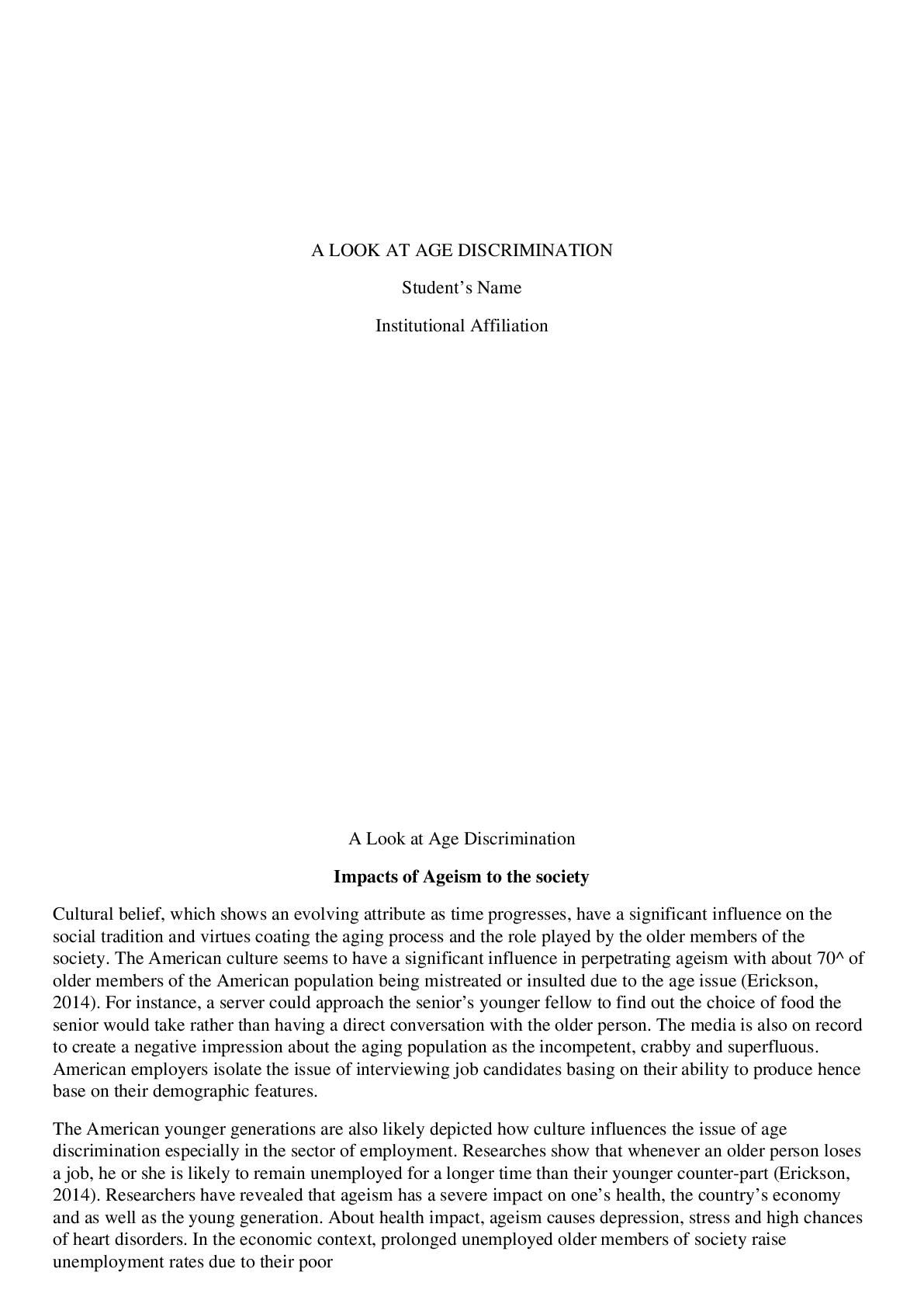
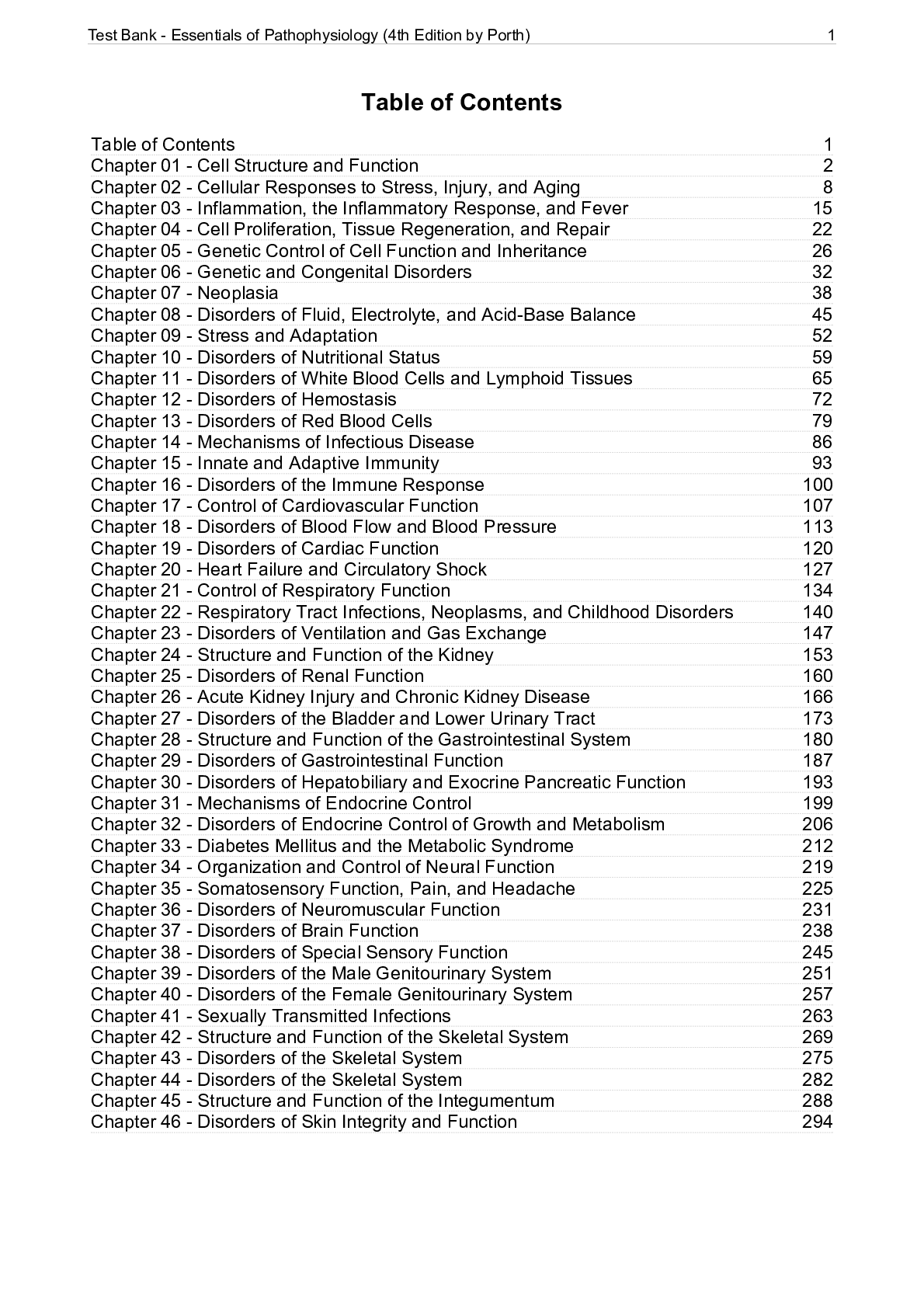
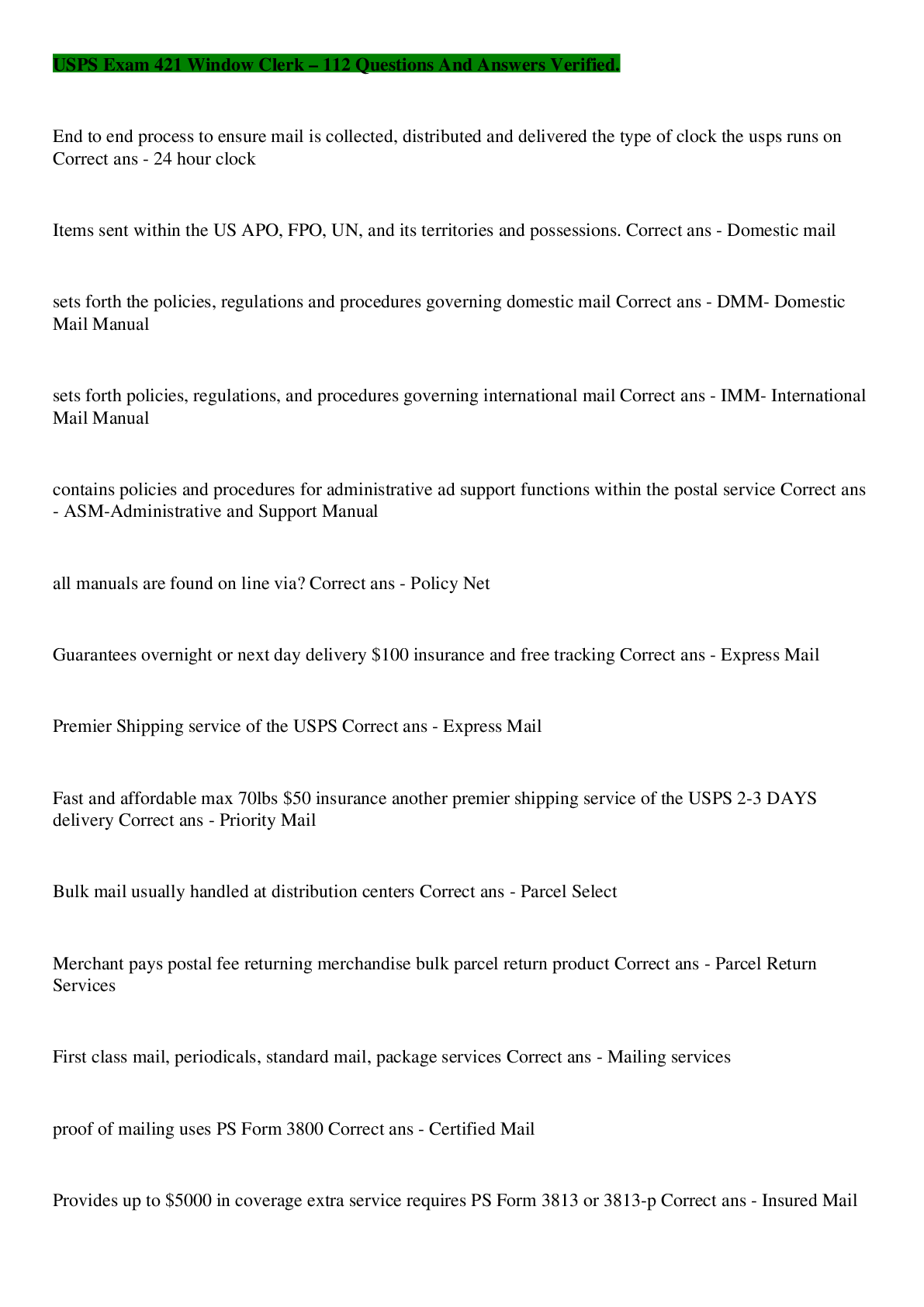
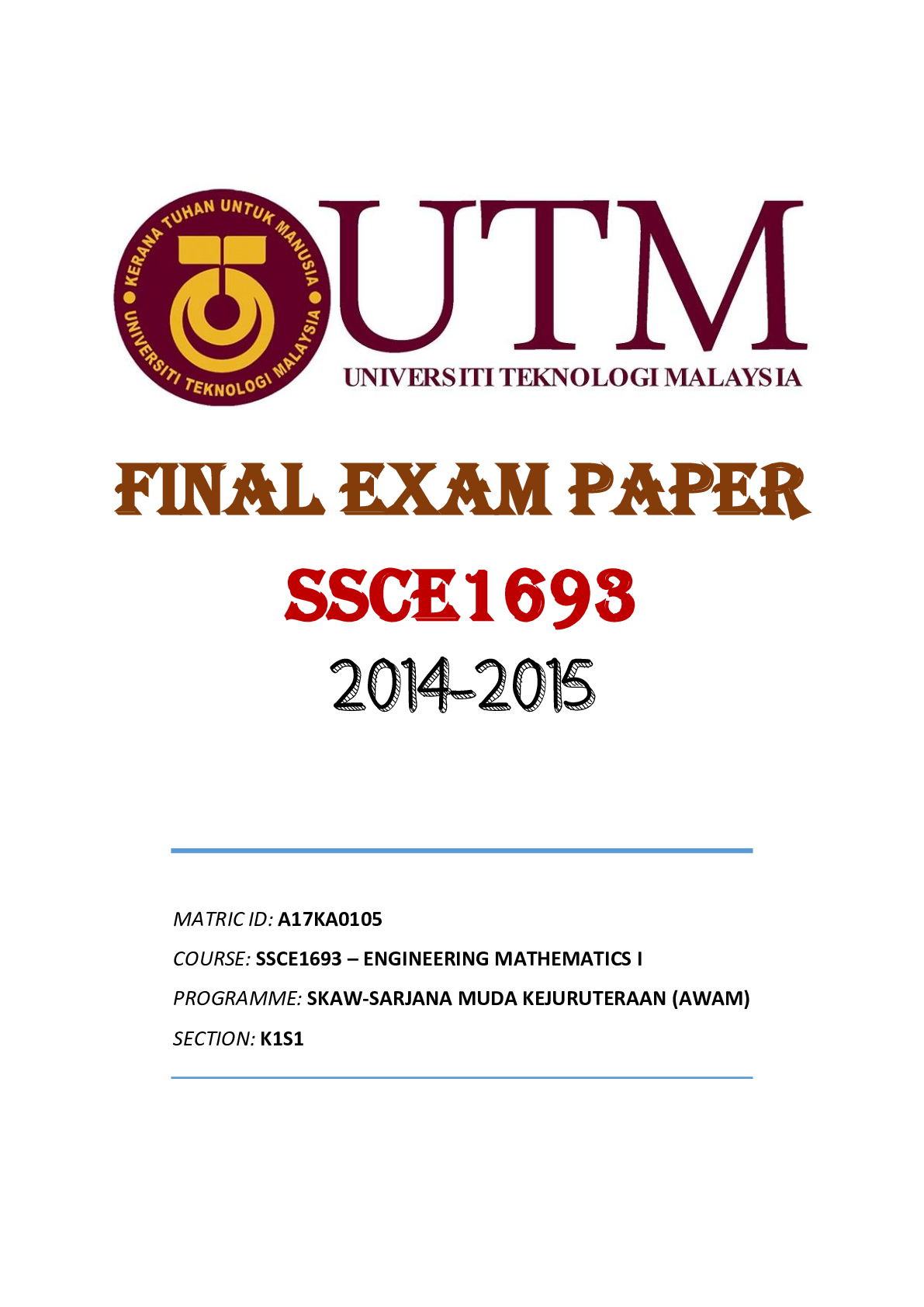

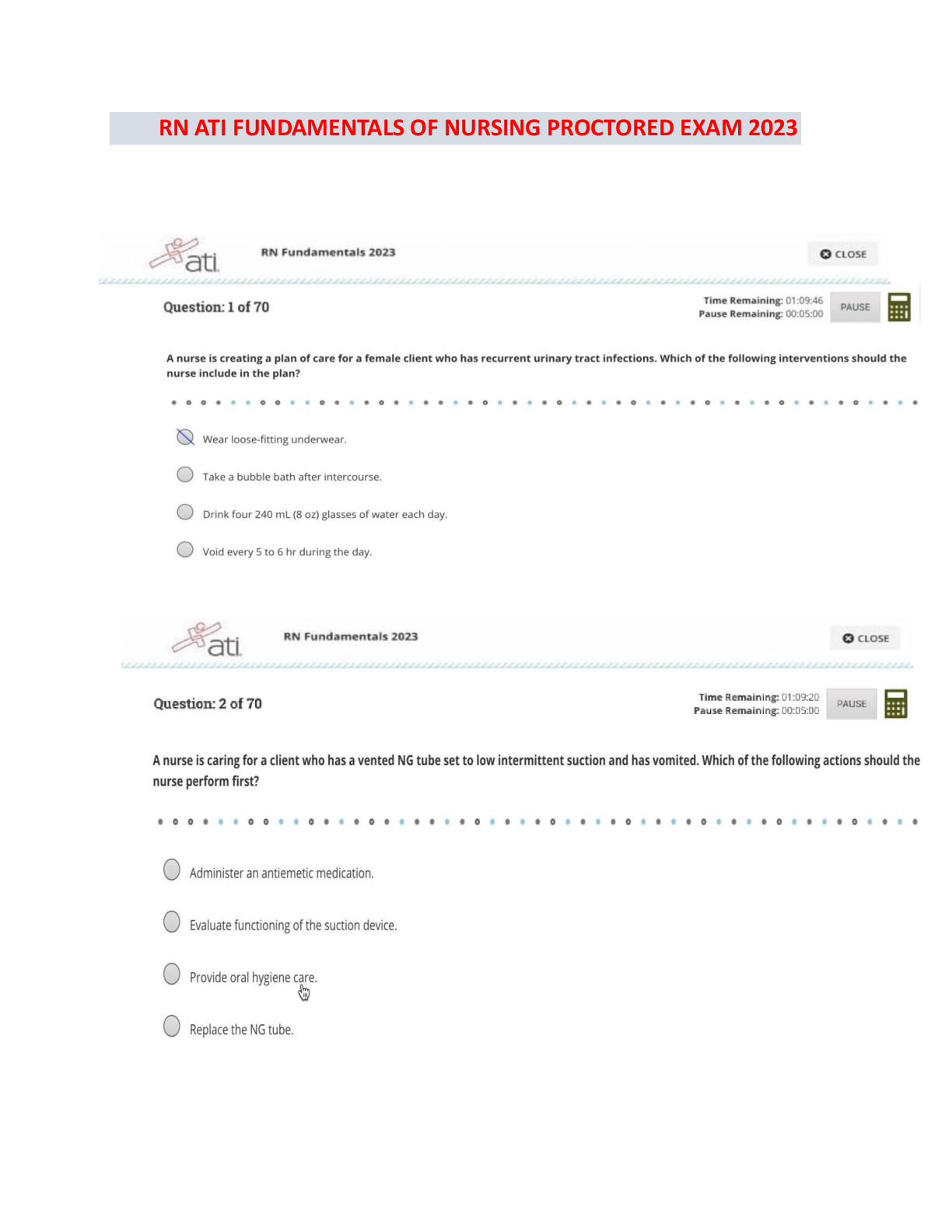






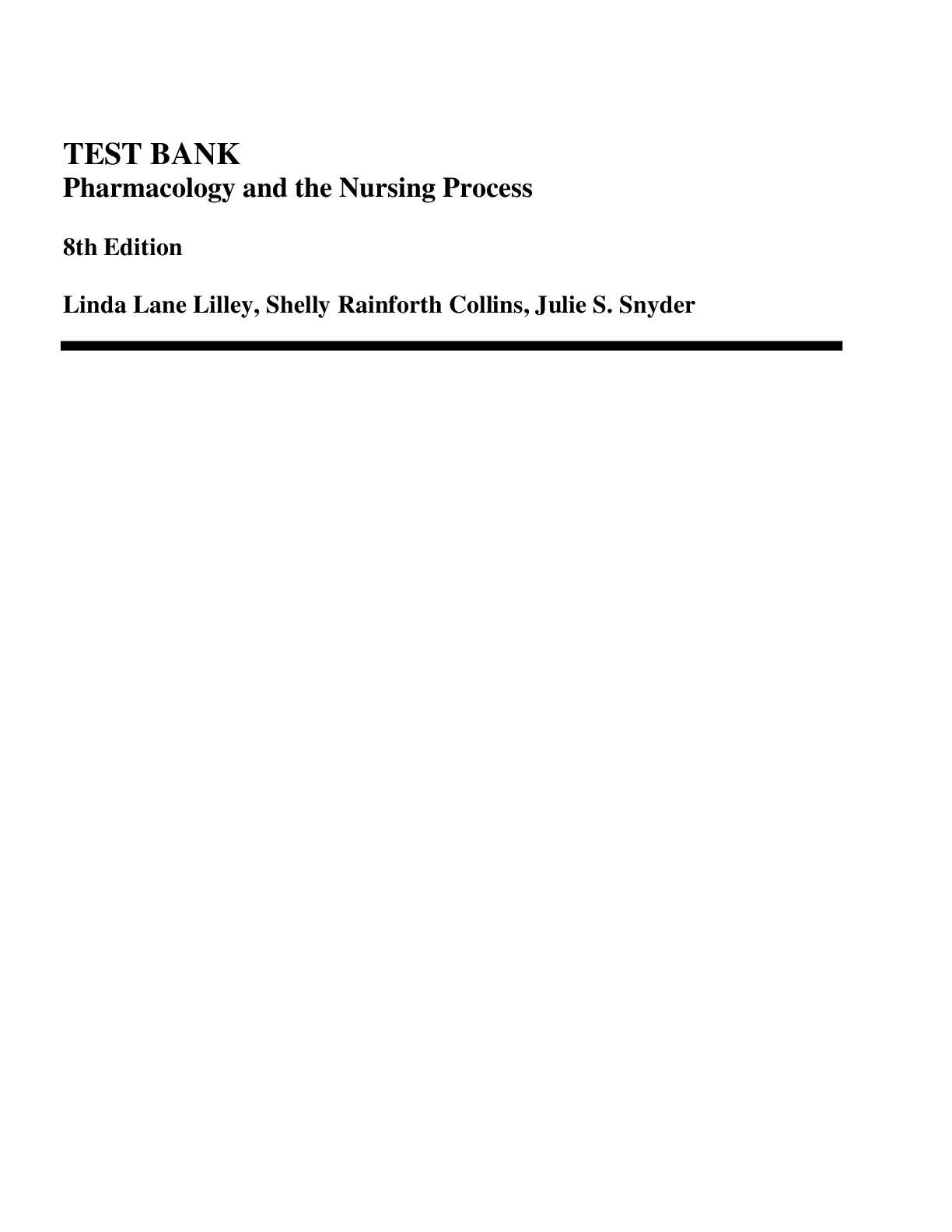


_compressed.png)


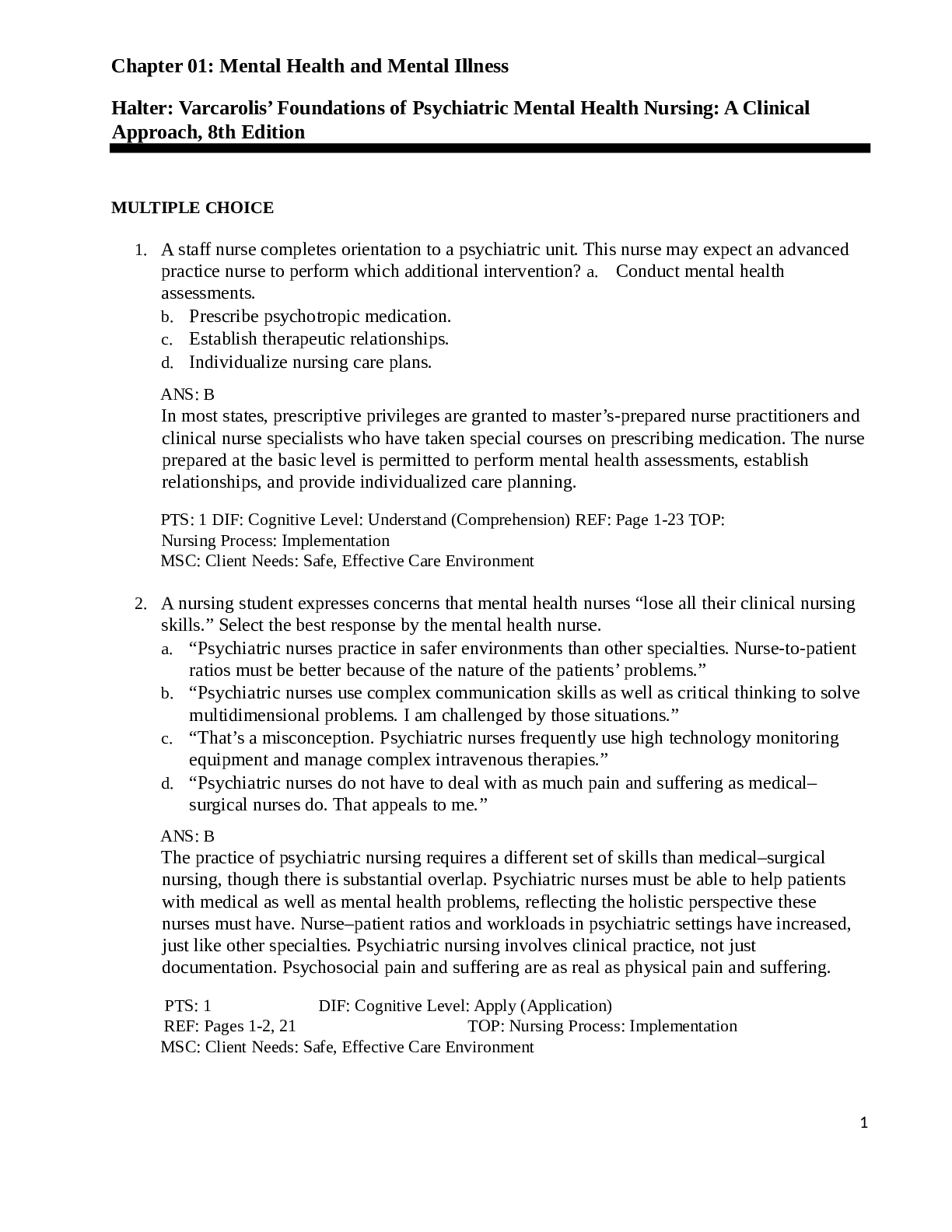

 (1).png)

